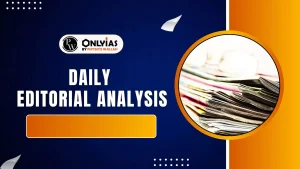The United States imposed 25% reciprocal tariffs on India’s exports with effect from August 7.
- On August 6, the U.S. imposed a penal levy of an additional 25% on India’s exports.
US-India Trade Relations
- Point of contention for the US: The United States stands as India’s largest single-country export market.
- In 2024-25, India exported goods worth $87.4 billion to the US, while importing goods worth $45.7 billion, resulting in a substantial trade surplus of $41.7 billion for India.
- This surplus has consistently been a point of contention for the US, especially under former President Trump’s administration, which seeks to reduce its trade deficit with countries like India and China.
- Trump previously addressed this issue during his 2016-2020 tenure by revoking India’s Generalized System of Preferences (GSP) status.
- This removal meant that Indian goods, which previously entered the US duty-free or at reduced tariffs, were now subject to duties.
Types of Tariffs Imposed by the US
The US has imposed two main types of tariffs on India:
- Reciprocal Tariffs: A 25% reciprocal tariff was applied to India’s exports from August 1, 2025, after a trade deal failed to materialize by the deadline.
- The US justified these as “reciprocal” because India also imposes tariffs on US goods.
- Penal Levy: An additional 25% penal levy was imposed due to India’s continued purchase of oil from Russia.
- This is a “penalty” aimed at influencing India’s foreign policy regarding Russia.
- The US itself imports significant goods, such as uranium, from Russia, and other countries like China purchase more Russian oil than India, yet these actions are not similarly penalised.
Impact of Tariffs on India’s Economy
- Impact on Exports: Economic models suggest that a 1% increase in tariffs leads to a 1% decrease in exports.
- Therefore, the 25% reciprocal tariff alone is projected to reduce India’s exports to the US by 25%, resulting in an estimated loss of $21.85 billion from the 2024-25 export value of $87.4 billion.
- Some Indian products will face a cumulative 50% tariff (25% reciprocal + 25% penal) when entering the US market.
- This significantly increases the cost of goods like gems, jewellery, and even iPhones assembled in India, making them less competitive in the US market.
- Worsening Current Account Deficit (CAD):
- A reduction in exports directly contributes to a wider Current Account Deficit.
- The CAD is expected to increase from 0.6% to 1.15% of GDP due to these tariffs.
- A higher CAD implies that India is spending more on imports, foreign payments, and loan servicing than it earns from exports, remittances, and investments.
- Slowdown in GDP Growth:
- The 25% tariffs are estimated to reduce India’s real GDP growth by 0.3% to 0.6% points, from a base of 6.5% to a projected range of 5.9% to 6.2%.
- The combined effect of both tariffs (reciprocal and penal levy) could severely impact India’s growth rate, leading to a reduction of over 0.6 percentage points from the baseline growth rate of 6.5% in the current year.
- Increased Inflation: The penal levy on Russian oil could compel India to seek oil from alternative, more expensive sources like the US or Gulf countries.
- Higher fuel costs directly translate into increased prices for all products, leading to an upsurge in domestic inflation.
- Geopolitical Dimension: The US intends to distance India from Russia, but this could paradoxically push India closer to Russia, as India might perceive the US as an unreliable partner.
Factors that can moderate the negative effects of the tariffs
Despite the severe potential impacts, some factors could moderate the negative effects:
- New Free Trade Agreements (FTAs): India has recently signed comprehensive economic and trade agreements with countries like the United Kingdom and the United Arab Emirates, and negotiations are underway with the European Union.
- These agreements could diversify India’s export markets and offset some losses from the US market.
- Competitor Tariffs: The US has also imposed tariffs on other countries that compete with India’s exports, such as China and Vietnam.
- This means that Indian goods are not uniquely disadvantaged in the US market, as competitors’ products also face higher costs.
- Rupee Depreciation: Since the tariffs were imposed, the Indian Rupee has significantly depreciated against the US Dollar, reaching approximately ₹87.5 per dollar.
- A weaker rupee makes Indian exports cheaper and more attractive to buyers in the US and other countries, potentially boosting overall exports and helping to narrow the CAD.
Measures to mitigate the risks posed by these tariffs
Short-Term Policy Options
- Tough Negotiations: India must continue negotiating firmly with the US, safeguarding critical sectors such as agriculture, allied sectors, and Micro, Small, and Medium Enterprises (MSMEs) from any compromises.
- Export Diversification: Actively seek and develop new export markets.
- India can learn from China, which expanded into markets in Latin America and Africa after facing trade tensions with the US in 2008.
- Tariff Rationalization: Review and reduce import tariffs on raw materials and intermediate goods that are used in the production of export-oriented products.
- High import duties on these inputs increase the cost of Indian exports, making them less competitive.
Long-Term Policy Options
- Revive WTO: India should collaborate with like-minded countries such as the European Union and Japan to push for reforms and the revival of the World Trade Organization’s (WTO) dispute resolution mechanism. This would provide India a dynamic multilateral platform to address trade disputes.
- Regional Pacts: India should reconsider and potentially join more regional trade agreements, such as the Regional Comprehensive Economic Partnership (RCEP), which India previously chose not to sign.
- These agreements can provide preferential access to large regional markets.
Conclusion
The continuity of such a protectionist trade regime is detrimental to all nations, including the US and India.
- India must act decisively and strategically to safeguard its economic interests and ensure sustained growth.
![]() 9 Aug 2025
9 Aug 2025

